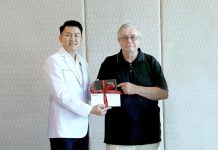A couple of weeks ago, a call went out to the farang population in Thailand for some Rh negative blood. This happens around three times a year, and each time this stimulates some of our more public spirited foreigners to ask why there is a shortage, and what can be done about it?
The basic problem does come down to some of the many differences between Caucasian races and Asian races, and I’m not talking about cultural differences here. Just as there is a difference in hair types and skin types, there are differences in blood types as well.
The question is often asked as to why the blood collection agencies just don’t stock up on the rarer groups, so there is always some to call upon. Unfortunately it isn’t that easy, as the ‘shelf life’ of blood is only around 30 days.
Blood transfusions and blood banks only came about in the 1930’s with Sergei Yudin of Russia organizing the world’s first blood bank at the Nikolay Sklifosovskiy Institute, which set an example for the establishment of further blood banks in different regions of the Soviet Union and in other countries. By the mid-1930s the Soviet Union had set up a system of at least sixty five large blood centers and more than 500 subsidiary ones, all storing blood and shipping it to all corners of the country.
News of the Soviet experience traveled to the United States, where in 1937 Bernard Fantus, director of therapeutics at the Cook County Hospital in Chicago, established the first hospital blood bank in America. In creating a hospital laboratory that preserved and stored donor blood, Fantus coined the term ‘Blood Bank’. Within a few years, hospital and community blood banks were established across the United States and in 1940 Willem Johan Kolff organized the first blood bank in Europe.
With the discovery of blood groups, generally classified by the ABO system (so we are generally either A, B, O or AB) it was soon apparent that there were differences in their distribution in the world. There are many reasons for this, including susceptibility to disease of various blood groups, population drifts, inter-marriage and others. However, the end result is that simplistically the Asian population has a different distribution of ABO groups from the Caucasian population; for example, blood group B is far more predominant in the East than in the West.
When you look at one of the other blood typing systems, the Rhesus grouping into Positive or Negative, even greater disparities become apparent. The Asian population has very little Rhesus Negative (0.3 percent), compared to the Caucasians (15 percent). For interest, 50 percent of Basques are Rhesus Negative, one of the highest in the world.
Recently there has been the discovery of another blood type called the Bombay group. This is a version of O +ve, that was not compatible with the usual O +ve blood. First identified in Mumbai, from which the group derives its name, so far there have been just 179 such cases reported in India. However, even in India, there have been cases where doctors could not find a donor for transfusion of the Bombay group blood that would have been necessary. Even though it has first been identified in Mumbai, the city is now believed to have just 35-40 people with the group.
Consequently, you can see that when there is a need for blood for a number of injured Caucasians in an Asian country, the chances of there being sufficient blood stocks are virtually nil.
If you are a farang resident in Thailand, please have your blood grouped and if you are Rhesus Negative, go on a register at the local Red Cross, or even the nearest large hospital, so that you can be called upon in emergencies.
Currently, post disaster (or ‘between disasters’) there is no desperate shortage, but since blood does not keep ‘forever’ there will be times in the future when we will need Rhesus Negative blood, so don’t spill it in the streets, spill it at the Red Cross!
My hospital has regular donation days in conjunction with the Red Cross, so keep that in mind too.




